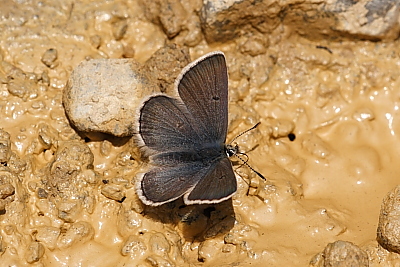
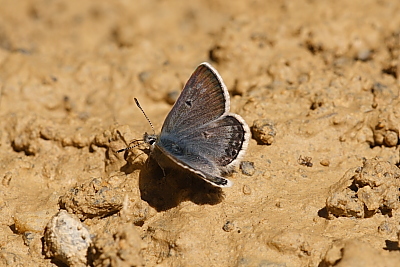
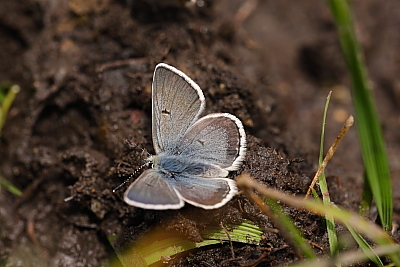
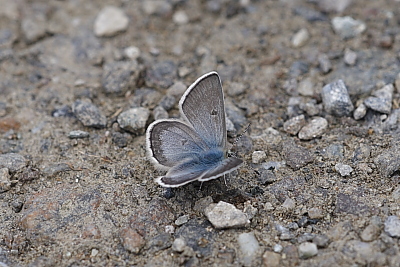
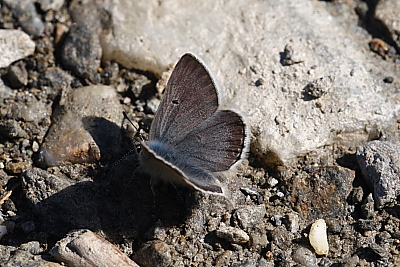
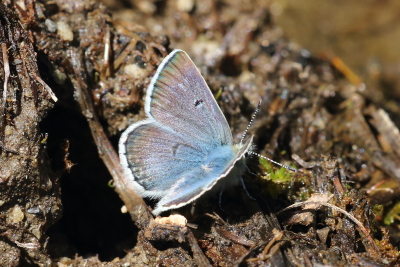
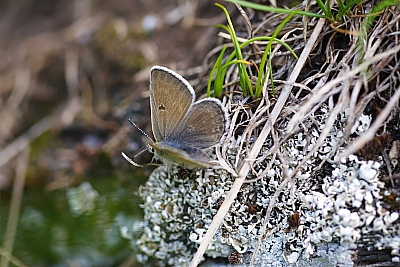
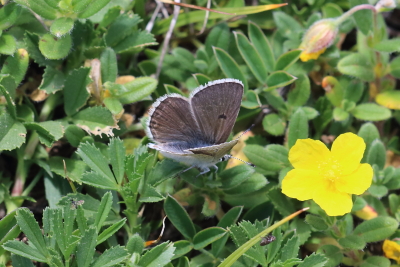
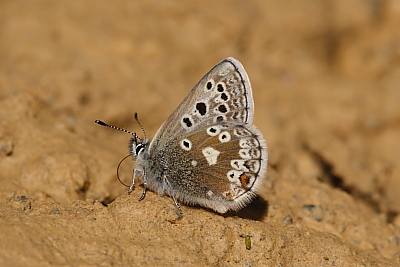
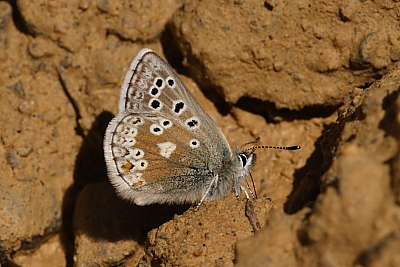
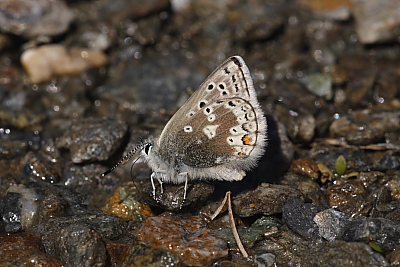
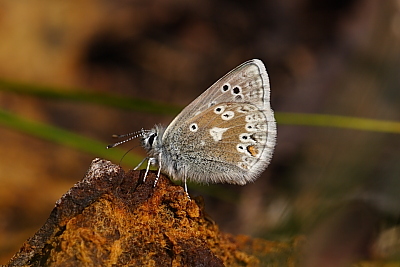
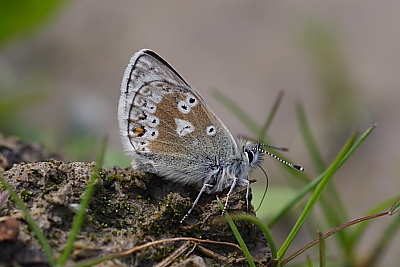
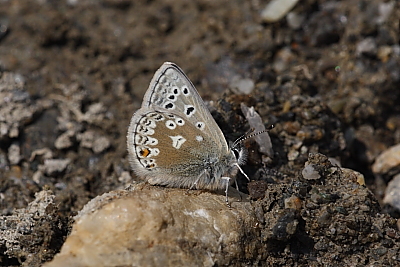
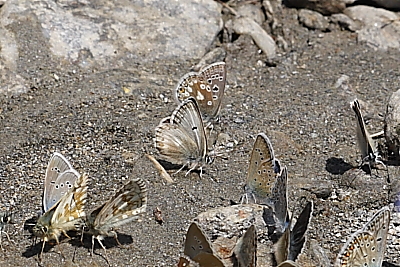
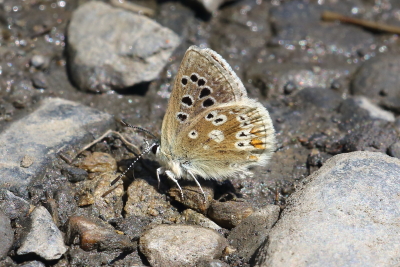
Glandon Blue (Plebejus glandon)
2024 photographs highlighted in yellow. Click on any photograph to go to an enlarged picture, or simply scroll down the page.
| Plebejus glandon_52748_male_Savoie | Plebejus glandon_52748_male_Savoie | 1930 |
|
Glandon is a high altitude species being found in the Alpes and the Pyrénées in France, the lower end of the altitude range being around 1800m. The male is a rather dull grey blue, but quite attractive nonetheless, and slightly smaller than the average Common Blue (Polyommatus icarus). It is not possible to confuse glandon with any other species in the Alpes, only the very similar Gavarnie Blue (P. pyrenaicus) which only occurs in the Pyrénées where both can fly together, something I first experienced in 2023.
Glandon is often seen puddling, in fact I only ever seen males when they are puddling, when it is often sedentary and can be quite hard to spot on a grey stony surface. I had never seen a female until 2010 when I managed to see 21926; they appear to be very reclusive. Until 2008 I had only seen glandon in odd ones or twos at a few locations each year, but in 2009 it appeared in greater numbers in quite a few sites, and in 2010 I visited several places in the Alpes where it was relatively frequently-encountered and occasionally common; in one spot in the Queyras National Park there were some fifty or so puddling together. |
Having now seen good numbers of glandon, it seems to me to be quite variable in both the upperside and underside. The upperside seems to vary in the degree and darkness of the blue scales, some specimens appearing quite dark, and in the degree of marginal markings on the uph. The undersides seem to vary from the unh clean brown of 27139 to the dark grey basal suffusion of 22408. The underside markings are quite distinctive and unlike any other species in the western Alpes.
This species was previously known as Agriades glandon. In 2010 it was reclassified as Plebejus glandon and in 2017 it was again reclassified back to Agriades glandon. I'll give it a few years before changing the web page (and all the occurrences and links associated) as it is entirely possible that the taxonomists will change it again. |
| ref | sex |
observations |
alt. m |
| 17613 | M | a very dark male, probably an effect of the high altitude. | 2100 |
| 17652 | M |
a slightly darker than average male, with quite pronounced uph marginal markings. |
2100 |
| 17770 | M | fairly normal, paler but still at the same altitude as the other two above. | 2100 |
| 22105 | M | fairly typical. | 2020 |
| 22200 | M | quite extensive uph blue scaling, well-defined thus suggesting a wide dark uph border, appearing not dissimilar to the Silvery Argus (Aricia nicias). The upf and uph discoidal spots are also unusually large. | 2020 |
| 22309 | M | a rather dark male, with only vestigial uph marginal markings. | 2020 |
| 52748 | M | a particularly light grey-blue colouring which would appear natural and not as a result of ageing. I only saw this one specimen at this location in Savoie, so it is hard to say whether this was normal for the northern region of the French Alpes (as compared to the Hautes-Alpes). | 1930 |
| 21926 | F | lacking the blue scaling of the male and appearing a rather dull cold brown. | 2020 |
| 48605 | F | a female, a rather dull dark grey-blue, with a sign of some ageing, but females of these high altitude blues are seen only rarely. | 2290 |
| 17654 | M | slightly darker and more heavily marked than average. | 2100 |
| 17637 | M | fairly typical, seen at slightly lower altitude than the others on this page. | 1890 |
| 22330 | M | quite a clean unh brown ground colour. | 2040 |
| 22408 | M |
quite a dark grey unh and a strong, almost black, basal suffusion. |
2020 |
| 27009 | M | a brownish and lightly marked underside. | 2010 |
| 27139 | M | a rather pale and lightly marked underside. | 2040 |
| 33439 | M | a fresh and very crisply marked male. | 2040 |
| 38217 | M | I only really noticed this aberration of glandon when I looked closely at the photograph of some hundred or so butterflies puddling at this small spot. I am rather assuming that it is glandon, mainly because it doesn't seem to fit anything else, and it is the only aberration I have ever seen of this species, even though its marking can be quite variable. | 2020 |
| 51423 | M | a male from the Pyrénées with a very much softer and warmer ground colour than its counterparts from the Alpes. It was flying in company with its very close cousin, the Pyrénées endemic Gavarnie Blue (P. pyrenaicus). | 1700 |
17613_male_Hautes-Alpes_09Jul09
17652_male_Hautes-Alpes_09Jul09
17770_male_Hautes-Alpes_10Jul09
22200_male_Hautes-Alpes_14Jul10
22309_male_Hautes-Alpes_15Jul10
21926_female_Hautes-Alpes_11Jul10
48605_female_Hautes-Alpes_20Jul21
17654_male_Hautes-Alpes_09Jul09
17637_male_Hautes-Alpes_09Jul09
22408_male_Hautes-Alpes_15Jul10
27009_male_Hautes-Alpes_12Jul11
27139_male_Hautes-Alpes_14Jul11
33439_male_Hautes-Alpes_7Jul13
38217_male_Hautes-Alpes_7Jul15
51423_male_Hautes-Pyrénées_10Jul23